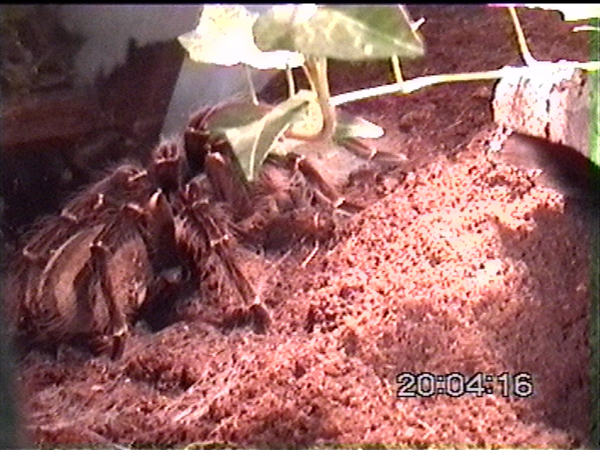Goliath birdeater (Theraphosa blondi) [Photo] An 8-year-old, female Theraphosa blondi
From Wikipedia, the free encyclopedia
The Goliath birdeater (also called the Bird eating spider) (Theraphosa blondi) is a arachnid which belongs to the tarantula family, and is arguably the largest spider in the world. Native to the rain forest regions of northern South America, these spiders have up to a 30 centimetre (12 in) long leg span when fully extended and can weigh over 120 grams. Wild Goliath birdeaters are a deep burrowing species, found commonly in marshy or swampy areas. Goliath bird eaters usually live in burrows in the ground that they have either dug themselves or have been previously abandoned by rodents or other similar creatures.
Female birdeaters mature in 2.5-3 years and have an average life span of 6 to 14 years. Males die soon after maturity and have a lifespan of 3 to 6 years. Colours range from dark to light brown with faint markings on the legs. Birdeaters have hair on their bodies, abdomens, and legs. The female lays anywhere from 100 to 400 eggs, which hatch into spiderlings within two months.
The Goliath birdeater is fairly harmless to humans, as are most species of tarantulas. Like all tarantulas, it has fangs large enough to break the skin of a human (1-2.5 cm). They do carry venom in their fangs and have been known to bite humans when threatened, but the venom is relatively harmless and just causes swelling and mild pain for a few hours (like a wasp sting). Tarantula bites to humans are usually in self-defense and do not always contain spider venom - what is known as a "dry bite". The goliath spider also does not have very good eyesight and mainly relies on vibrations in the ground that they can sense from their burrows in the ground.
Birdeaters are defensive and may make a hissing noise when disturbed. This noise is called stridulation, and is produced when the spider rubs the bristles on its legs together. Birdeaters can defend themselves by biting or by kicking their barbed hairs towards their perceived assailant. These hairs can be severely irritating to the skin and lungs, and have been reported to feel like shards of fiberglass.
Despite its name, the Goliath birdeater does not normally eat birds. Rather, it eats mostly invertebrates such as crickets, mealworms and moths, and also small vertebrates such as frogs, mice, and lizards. The Goliath birdeater is one of the few tarantulas which can capture and eat a full-grown mouse.
